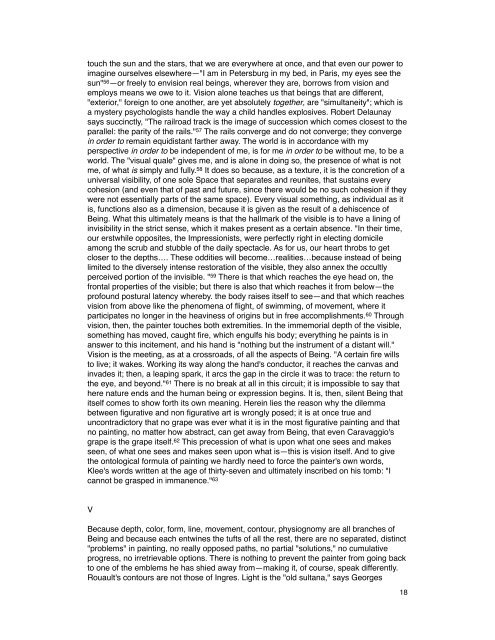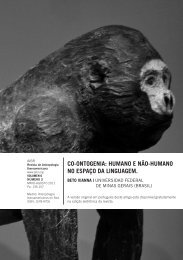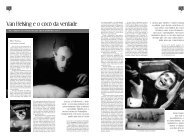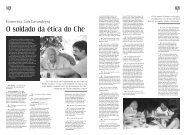Merleau-Ponty, 1964. Eye and mind. - Biolinguagem
Merleau-Ponty, 1964. Eye and mind. - Biolinguagem
Merleau-Ponty, 1964. Eye and mind. - Biolinguagem
- No tags were found...
Create successful ePaper yourself
Turn your PDF publications into a flip-book with our unique Google optimized e-Paper software.
touch the sun <strong>and</strong> the stars, that we are everywhere at once, <strong>and</strong> that even our power to<br />
imagine ourselves elsewhere—"I am in Petersburg in my bed, in Paris, my eyes see the<br />
sun" 56 —or freely to envision real beings, wherever they are, borrows from vision <strong>and</strong><br />
employs means we owe to it. Vision alone teaches us that beings that are different,<br />
"exterior," foreign to one another, are yet absolutely together, are "simultaneity"; which is<br />
a mystery psychologists h<strong>and</strong>le the way a child h<strong>and</strong>les explosives. Robert Delaunay<br />
says succinctly, "The railroad track is the image of succession which comes closest to the<br />
parallel: the parity of the rails." 57 The rails converge <strong>and</strong> do not converge; they converge<br />
in order to remain equidistant farther away. The world is in accordance with my<br />
perspective in order to be independent of me, is for me in order to be without me, to be a<br />
world. The "visual quale" gives me, <strong>and</strong> is alone in doing so, the presence of what is not<br />
me, of what is simply <strong>and</strong> fully. 58 It does so because, as a texture, it is the concretion of a<br />
universal visibility, of one sole Space that separates <strong>and</strong> reunites, that sustains every<br />
cohesion (<strong>and</strong> even that of past <strong>and</strong> future, since there would be no such cohesion if they<br />
were not essentially parts of the same space). Every visual something, as individual as it<br />
is, functions also as a dimension, because it is given as the result of a dehiscence of<br />
Being. What this ultimately means is that the hallmark of the visible is to have a lining of<br />
invisibility in the strict sense, which it makes present as a certain absence. "In their time,<br />
our erstwhile opposites, the Impressionists, were perfectly right in electing domicile<br />
among the scrub <strong>and</strong> stubble of the daily spectacle. As for us, our heart throbs to get<br />
closer to the depths…. These oddities will become…realities…because instead of being<br />
limited to the diversely intense restoration of the visible, they also annex the occultly<br />
perceived portion of the invisible. " 59 There is that which reaches the eye head on, the<br />
frontal properties of the visible; but there is also that which reaches it from below—the<br />
profound postural latency whereby. the body raises itself to see—<strong>and</strong> that which reaches<br />
vision from above like the phenomena of flight, of swimming, of movement, where it<br />
participates no longer in the heaviness of origins but in free accomplishments. 60 Through<br />
vision, then, the painter touches both extremities. In the immemorial depth of the visible,<br />
something has moved, caught fire, which engulfs his body; everything he paints is in<br />
answer to this incitement, <strong>and</strong> his h<strong>and</strong> is "nothing but the instrument of a distant will."<br />
Vision is the meeting, as at a crossroads, of all the aspects of Being. "A certain fire wills<br />
to live; it wakes. Working its way along the h<strong>and</strong>'s conductor, it reaches the canvas <strong>and</strong><br />
invades it; then, a leaping spark, it arcs the gap in the circle it was to trace: the return to<br />
the eye, <strong>and</strong> beyond." 61 There is no break at all in this circuit; it is impossible to say that<br />
here nature ends <strong>and</strong> the human being or expression begins. It is, then, silent Being that<br />
itself comes to show forth its own meaning. Herein lies the reason why the dilemma<br />
between figurative <strong>and</strong> non figurative art is wrongly posed; it is at once true <strong>and</strong><br />
uncontradictory that no grape was ever what it is in the most figurative painting <strong>and</strong> that<br />
no painting, no matter how abstract, can get away from Being, that even Caravaggio's<br />
grape is the grape itself. 62 This precession of what is upon what one sees <strong>and</strong> makes<br />
seen, of what one sees <strong>and</strong> makes seen upon what is—this is vision itself. And to give<br />
the ontological formula of painting we hardly need to force the painter's own words,<br />
Klee's words written at the age of thirty-seven <strong>and</strong> ultimately inscribed on his tomb: "I<br />
cannot be grasped in immanence." 63<br />
V<br />
Because depth, color, form, line, movement, contour, physiognomy are all branches of<br />
Being <strong>and</strong> because each entwines the tufts of all the rest, there are no separated, distinct<br />
"problems" in painting, no really opposed paths, no partial "solutions," no cumulative<br />
progress, no irretrievable options. There is nothing to prevent the painter from going back<br />
to one of the emblems he has shied away from—making it, of course, speak differently.<br />
Rouault's contours are not those of Ingres. Light is the "old sultana," says Georges<br />
18









